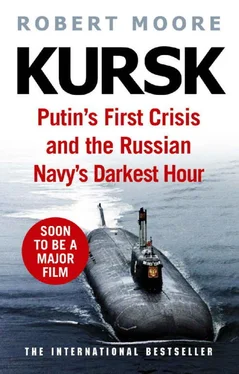What shocked the investigators was the fact that twelve men had died and a submarine had been lost – without the torpedo warhead even detonating. All the destructive power had been in the propulsion system. The Royal Navy decided then and there that hydrogen peroxide was too volatile to be stored within the unforgiving confines of a torpedo room, and never again did a British submarine go to sea with weapons that used HTP.
Russia’s Northern Fleet had issued no such edict. Aboard the Kursk the 65-76 torpedo lay silently in its tube. Poised for launch, the potent HTP chemical cocktail was ready for ignition.
Seven men were crammed into the small passageways of the torpedo room that day, including Mamed Gadjiev, the only civilian on board. He was from Dagestan in the Russian Caucasus, and he worked in a run-down factory that produced many of the Navy’s torpedoes. A talented and serious man in his mid-thirties, Gadjiev’s engineering background was in aeronautics. He had studied in the Ukraine before switching to the plant on the shores of the Caspian Sea to be close to his wife and two teenage daughters. Gadjiev was aboard the Kursk to supervise a test of a new battery for the USET-80 torpedo, the second weapon that was to be launched that Saturday morning.
As he stood in the torpedo room, listening to the crew run through the launch checklist, his technical knowledge and engineer’s instinct would have given him no advance warning that something was going terribly wrong. The reservoir of colourless HTP was seeping through gaskets deep inside the casing of the 65-76 torpedo. Although an inexorable chemical reaction had begun, it must have been invisible to those in the torpedo room.
The explosive power needed to drive an 11-metre-long, five-ton torpedo at a speed of thirty knots for up to fifty miles was about to annihilate the forward compartment of the Kursk . As the reaction accelerated, Gadjiev may have experienced a few seconds of paralysing horror, fleetingly aware of the enormous destructive forces that were building.
The torpedo exploded in a massive fireball at exactly 11.28:27, with a force equivalent to 100 kilograms of TNT. The blast registered 1.5 on the Richter scale – the size of a small earth tremor.
With the torpedo doors still shut, the energy burst backwards into the compartment, travelling at more than a thousand metres a second, engulfing all seven men in a rush of flames.
Mamed Gadjiev, Abdulkhadur Ildarov, Alexei Zubov, Ivan Nefedkov, Maxim Borzhov, Alexei Shulgin, Arnold Borisov.
They were incinerated with merciful speed, by forces of overwhelming power.
Immediately behind the torpedo room, in the second compartment, lies the operational heart of the submarine, where thirty-six men were at their posts. Normally, the command centre is manned by thirty-one officers and sailors, but on this voyage an additional five senior, shore-based officers were monitoring the performance of the submarine and her command team. In the control room, at the periscope or close by, stood Captain Lyachin. Next to him sat Sergei Tylik, the twenty-four-year-old with submarining in his blood, watching over his sonar and acoustic equipment.
The explosion ripped through the second compartment with fury, throwing men from their posts and hurling them against the machinery and pipework that surrounded the control room. Submariners who have experienced depth charges talk of their harrowing psychological impact: the fear, the uncertainty of what happens next, the sense of having nowhere to hide. This explosion was on a much greater scale, and inside the submarine.
Security forces use stun grenades to incapacitate people because the intense noise and flash of light overwhelms and numbs the human mind. Lyachin, Tylik and all those around them had been subjected to the shock of a stun grenade multiplied a hundred times. Their shock and disorientation must have been complete. They were in no position to halt the sequence of explosions, ruptures and avalanching electrical failures that doomed the submarine.
No-one who has experienced explosions in a submarine on this scale has survived to relate the horror. The firsthand accounts that come closest are therefore those of the explosions of close-range depth charges. Few have recalled the unique psychology of being in peril in a submarine more vividly than Lothar-Günther Buchheim, who sailed in the German U-boat fleet during the Second World War. He has described the horror of successive concussions, the crew waiting for the hull to rupture, and the fatal rush of the icy ocean:
The impact has knocked two men down. I see a mouth shrieking, flailing feet, two faces masked in terror… My skull seems under the same extreme pressure as our steel skin… I see and feel everything going on around me with astounding clarity… I hear screams that seem to be coming from a long way off… I want to lie down and hide my head in my arms. No light. The crazy fear of drowning in the dark, unable to see the green-white torrent of water as it comes bursting into the boat…
Lyachin had no time to assess events. Even if he had shouted out orders, he would not have been heard. The explosion ruptured the eardrums of all those in the forward areas of the submarine. The noise of the detonation was itself intensified as hydraulic and compressed air running in pipes throughout the submarine burst into the compartments.
Behind the command centre, in the third compartment, lay the Kursk ’s radio room, the most secretive part of the submarine, accessed only with special keys and codes. Experienced Oscar II officers say that the communications equipment is set up so that when the submarine is at periscope depth, with her antennae extended, an emergency signal can be sent by punching just four or five keys. Commanding the radio room was Andrei Rudakov, the officer who was taking legal action against his own admirals to ensure the sailors were paid on time. Trained in the Pacific Fleet, regarded as tenacious and capable, Rudakov is described by his friends as a man who would have excelled in a crisis.
The Kursk ’s masts were all extended, just penetrating the ocean surface. At this depth and position Rudakov appeared to be in an excellent position to dispatch an immediate SOS. But no emergency communication was sent – neither on Northern Fleet encrypted channels nor on international distress frequencies. The radio room must have been badly damaged and Rudakov incapacitated, probably thrown to the deck and severely disoriented.
In the few seconds after the explosion, in horror and confusion, Lyachin and some of the men in the command centre must have struggled to regain their bearings. Despite injuries, they would have scrambled to assess the damage and open the air valves in order to bring the Kursk to the surface. Blowing air into the ballast tanks is a simple task that requires merely pressing a button on the control console. This would certainly have been the first action of any senior officer on board. But apparently it was already too late for that. If someone did reach and press the button, the submarine was too damaged to respond.
Even the emergency buoy, which is recessed into the casing of the outer hull, failed to function. The device is linked to sensors that detect a range of emergency conditions, such as increasing pressure inside the submarine, flooding or fire, all of which should automatically trigger the buoy’s release, sending it shooting upwards on a cable. On reaching the surface, an antenna begins to transmit distress signals. Once the buoy is located, rescuers need only follow the cable down to the seabed to locate the missing submarine. Some Northern Fleet specialists claim that the Kursk ’s buoy had malfunctioned so many times that it had been welded down; others suggest that the sensors were destroyed by the explosion before they could trigger the buoy’s release. The startling truth is that during the Kursk ’s 1999 Mediterranean voyage there had been so much concern that the buoy would accidentally deploy and reveal the sub’s position to Western naval forces that the release mechanism in the third compartment had been overridden. Even during this summer exercise in home waters the mechanism lay deliberately disabled. The operating key in the machine that controlled the buoy had been removed.
Читать дальше












